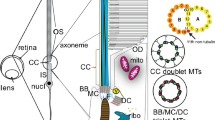Abstract
Existing hypotheses on the mode of disk formation in the photoreceptor cells of mammals appear to be incompatible: (1) plasma membranes of adjacent evaginations form a disk which, subsequently, is internalized by a disk rim; (2) pinocytotic vesicles are pinched off from the plasma membrane and fuse into a larger vesicle, which flattens and forms a disk. We have studied the development of the cone outer segment and the disk formation in Tupaia belangeri by transmission electron microscopy. During the first two postnatal weeks, the distal part of the single cilium, which is inserted apically on the inner segment, becomes balloon-shaped. Apical to the axoneme, it contains tubular and vesicular material, which, most probably, has been detached from the axonemal microtubules. These tubules and vesicles do not contribute to disks. The balloon-shaped expansion, later retained as the ciliary backbone, establishes the contact with the pigment epithelium. Formation of disks, from the 12-day-old Tupaia onwards, occurs between adjacent evaginations at the outer segment base. The initial disk rims are “hooked” to the ciliary axonemal microtubules. The axonemal microtubules are involved in the initiation and in the alignment of the disks. Disk rim formation and, thus, internalization of disks proceeds from the base to the apex of the outer segment, that is, from the younger to the older disks. In the adult Tupaia, an uneven progression of disk rim formation on both sides of the axoneme is found among consecutive disks. The seemingly incompatible hypotheses on the mode of disk formation reflect a heterochrony of the internalization of membranes and of the disk formation among different mammals and, possibly, between cones and rods.
Similar content being viewed by others
Author information
Authors and Affiliations
Additional information
Received: 24 July 1997 / Accepted: 10 September 1997
Rights and permissions
About this article
Cite this article
Knabe, W., Kuhn, HJ. Disk formation in retinal cones of Tupaia belangeri (Scandentia). Cell Tissue Res 292, 67–76 (1998). https://doi.org/10.1007/s004410051035
Issue Date:
DOI: https://doi.org/10.1007/s004410051035




